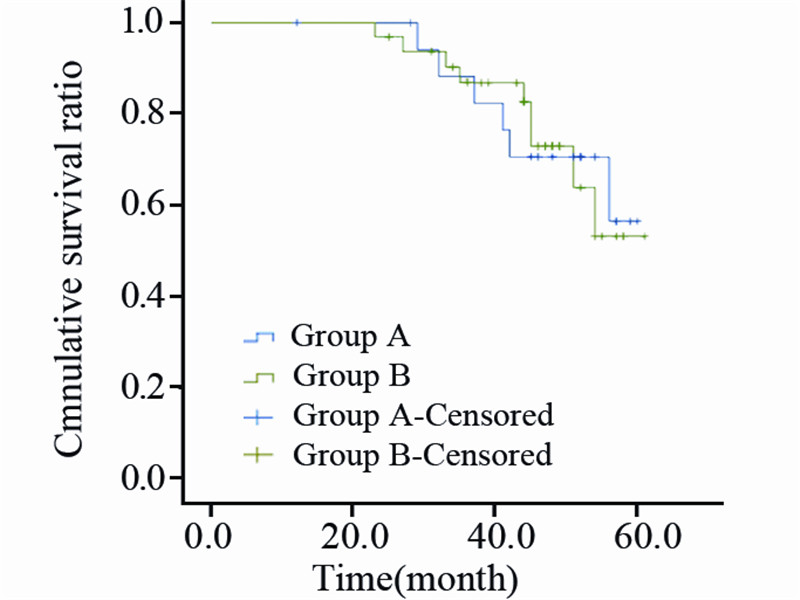文章信息
- 王乾,曹敬毅,王淇超,吴刚. 2015.
- WANG Qian, CAO Jingyi, WANG Qichao, WU Gang. 2015.
- 肌层浸润性膀胱癌保留膀胱术后髂内动脉灌注化疗的临床疗效
- Clinical Evaluation of Bladder-sparing Surgery Combined with Internal Iliac Artery Chemotherapy for Muscle-invasive Bladder Cancer Patients
- 肿瘤防治研究, 2015, 42(08): 810-813
- Cancer Research on Prevention and Treatment, 2015, 42(08): 810-813
- http://www.zlfzyj.com/CN/10.3971/j.issn.1000-8578.2015.08.013
-
文章历史
- 收稿日期:2014-11-26
- 修回日期:2015-04-23
目前治疗肌层浸润性膀胱癌(muscle-invasivebladder cancer,MIBC)的金标准为根治性全膀胱切除术[1],但此术式创伤较大、术后患者生活质量较低,部分患者因高龄及合并多种基础疾病等原因并不适合行根治性手术。Marks等最早提出了经尿道膀胱肿瘤切除术(TUR-BT)联合全身放化疗治疗MIBC,即保留膀胱手术联合术后辅助治疗,并取得了一定的临床疗效。保留膀胱术后辅助治疗的方式主要有全身化疗、放疗以及髂内动脉灌注化疗等,而髂内动脉灌注化疗因其具有对靶器官维持较高的药物浓度等特点,已运用于保留膀胱术后的辅助治疗或者术前的新辅助治疗,但目前对于髂内动脉灌注化疗适应症仍无统一意见,本研究回顾性分析2008年2月-2013年8月徐州市肿瘤医院TUR-BT术后行辅助髂内动脉灌注化疗的患者19例,与常规全身化疗进行对比,以进一步探讨髂内动脉灌注化疗的临床疗效并分析影响其预后的相关因素,为指导临床合理运用髂内动脉灌注化疗提供参考。
1 资料及方法 1.1 临床资料回顾性分析2008年2月-2013年8月于我院行保留膀胱手术的膀胱癌患者51例,病理检查证实均为浸润性尿路上皮癌;所有患者术后接受常规表柔比星50 mg膀胱灌注化疗,1次/月,共6次。其中术后辅助髂内动脉化疗19例(A组),平均年龄(66.4±9.8)岁,男13例,女6例;T2期10例,T3期9例;G1~2期2例,G3期17例;肿瘤单发17例,多发2例,肿瘤平均大小为(3.5±1.3) cm。术后辅助全身化疗32例(B组),平均年龄(67.1±8.9)岁,男22例,女10例;T2期17例,T3期15例;G1~2期3例,G3期29例;肿瘤单发29例,多发3例,肿瘤平均大小为(3.7±1.5) cm。两组在性别构成比、临床分期分级及肿瘤大小等临床资料方面相比差异无统计学意义(P>0.05),具有可比性。
1.2 化疗方法 1.2.1 髂内动脉化疗采用Seldinger法经皮股动脉穿刺插管,置管入双侧髂内动脉,注入吉西他滨1 000 mg/m2、顺铂30 mg/m2。根据肿瘤位置与大小调整剂量注入两侧髂内动脉。化疗后复查患者血常规及肝肾功能。动脉化疗每月1次,共1~3次。
1.2.2 全身化疗静脉滴注吉西他滨1 000 mg/m2(d1、8),顺铂30 mg/m2(d1~3),21天为1周期,连续4~6周期。
1.3 观察指标及随访方案化疗不良反应观察指标主要包含肝肾功能损伤、消化道症状(厌食、恶心以及呕吐等)以及骨髓抑制等;每3月行膀胱镜、B型超声、CT及胸片等检查,随访1年后改半年进行1次。
1.4 统计学方法采用SPSS17.0统计软件进行统计学数据分析,两组并发症计量资料比较采用t检验,计数资料比较采用c2检验,两组生存率计算及比较采用KaplanMeier法和Log rank法;相关分析采用多元Logistic回归分析,P<0.05为差异有统计学意义。
2 结果 2.1 随访情况51例患者随访9~64月,平均随访(57.3±8.2)月;随访方式均通过电话随访;随访起止时间2008年3月1日-2013年9月1日,失访3例,死亡19例。
2.2 两组患者5年累积生存率比较本研究结果显示A、B两组患者5年累积生存率分别为56.5%和53.2%,差异无统计学意义(P=0.18),见图 1。

|
| Group A: Internal iliac artery chemotherapy group; Group B: Chemotherapy group 图 1 两组肌层浸润性膀胱癌保留膀胱患者累积生存分析 Figure 1 Cumulative survival analysis of two groups of muscle-invasive bladder cancer(MIBC) patients |
A组膀胱保留率为78.9%(15/19)高于B组62.5%(20/32),差异有统计学意义(c2=5.063,P=0.024),A组患者治疗并发症发生率低于B组,差异有统计学意义(P=0.036),见表 1。
 |
单因素分析显示:髂动脉化疗组患者预后影响因素为肿瘤大小、临床分期、病理分级以及肿瘤数目,见表 2;进一步行多因素分析结果显示影响髂动脉化疗组患者预后的因素为肿瘤数目、临床分期以及病理分级,见表 3。
 |
 |
膀胱癌是我国泌尿系统最常见的恶性肿瘤之一,目前浸润性膀胱癌采用根治性膀胱切除同时行盆腔淋巴结清扫术是目前公认的治疗方案。然而,根治性膀胱切除术手术难度较大,手术并发症较多,因此不适用于部分预期寿命短、手术风险高的患者。自20世纪80年代起,一些保留膀胱的综合治疗模式被选择性地应用于治疗浸润性膀胱癌,长期随访结果提示患者的生存率与根治性全膀胱切除术相近[1]。但是,目前保留膀胱的综合治疗模式在病例的选择、化疗药物的选择﹑化疗方法等方面还没有具体的统一标准。目前国内外多报道(吉西他滨+顺铂)辅助化疗方案。而全身静脉化疗药物通过静脉随血液流向全身,因此很难在肿瘤位置维持较高的药物浓度,且全身不良反应较大,导致部分患者不能耐受全身化疗引起的不良反应而终止治疗,从而影响患者的远期疗效。因此选择一种行而有效的替代辅助治疗方案迫在眉睫[2, 3, 4]。
目前认为与全身化疗相比,髂内动脉化疗具有高选择性﹑高反应性以及低毒性等特点[5]。Chen等[6]采用药物代谢动力学模型比较两种方案,发现动脉化疗增加病灶局部药物浓度的同时减少了血液中药物水平。髂内动脉灌注对膀胱黏膜、黏膜下、肌层及膀胱周围组织及其可能受累的淋巴结及小静脉均有作用。Terashima[7]通过TUR-BT测定膀胱黏膜中铂类药物浓度,结果发现,动脉化疗比静脉化疗后膀胱黏膜铂浓度高2.7倍。Uyama等[8]报道狗动脉注射顺铂化疗后,膀胱黏膜和髂外淋巴结组织中铂的药物浓度分别是静脉化疗的2.5和2倍。但目前对于其适应证的选择仍无统一意见,因此其临床疗效仍被部分临床工作者所质疑。
本研究显示髂动脉化疗患者5年累积生存率与全身化疗患者相近,差异无统计学意义,提示了保留膀胱术后辅助髂动脉化疗的有效性,但膀胱保留率明显高于全身化疗组患者,且不良反应发生率较低,提示髂动脉化疗高反应性、低毒性等优势,考虑可能与髂内动脉灌注可使总用药量降低及维持靶器官较高的药物浓度有关。Miyanaga等[9]对MIBC患者保留膀胱手术后辅助动脉插管化疗,随访发现有81.7%的患者获得完全缓解。目前研究显示髂内动脉化疗后局部化疗药物的浓度为静脉化疗的8倍以上,从而提升了化疗药物对肿瘤组织杀伤作用;经动脉灌注化疗药物,可使药物在第一时间内到达靶组织且减少肾脏等器官对药物的代谢作用,从而减少对心、脑、肾等器官的毒副作用[10, 11]。
本研究单因素分析显示髂内动脉化疗预后与肿瘤大小、临床分期、病理分级以及肿瘤数目有关,进一步行多因素分析,结果显示影响髂动脉化疗患者预后的因素为临床分期、病理分级以及肿瘤数目。这与既往的研究结果基本一致[12, 13, 14, 15, 16]。关于肿瘤病理分级影响患者预后,考虑原因可能与G3期肿瘤出现复发以及进展的风险显著高于G1期肿瘤有关;同时本研究多因素分析结果显示肿瘤数目影响患者预后,考虑可能与肿瘤数目越多,出现肿瘤残留的风险亦随之提升,从而影响预后;另外,单因素结果提示肿瘤大小影响患者预后,但多因素分析结果提示其并不影响患者预后,考虑此因素可能与其他因素为同一主成分有关,如肿瘤越大,可能临床分期越高,即此因素可能在其他因素的协同下影响患者预后。Gospodarowicz报道MIBC保留膀胱的条件为:肿瘤分期T2~3、肿瘤<5cm、肿瘤距膀胱顶部较远、无原位癌病变等因素[17]。Miyanaga等[9]将肿瘤大小及数目作为评分依据,研究显示MIBC患者分值为0~1分适合行保留膀胱治疗,分值为2分应谨慎对待,有可能需要行根治性膀胱切除术。我们研究认为保留膀胱术后髂内动脉化疗适应于T2、单发肿瘤、病理分期为G1~2患者。
综上所述,我们预测经尿道膀胱癌电切术后髂内动脉灌注化疗治疗浸润性膀胱癌安全有效,在保证远期生存率的同时提高了膀胱保留率,且与传统全身化疗方案相比,具有耐受性好、不良反应轻等特点。对于T2期、G1~2期、单发的肌层浸润性膀胱肿瘤患者,TUR-BT术后辅以髂内动脉化疗不失为行之有效的治疗方式之一。
| [1] | Calabrò F, Sternberg CN. Neoadjuvant and adjuvant chemotherapy in muscle-invasive bladder cancer[J]. Eur Urol, 2009, 55(2):348-58. |
| [2] | Yang Y, Lei Y, Qin Y, et al. Bladder-sparing surgery combined internal lliac artery chemotherapy for invasive bladder cancer(report of 46 cases)[J]. Lin Chuang Mi Niao Wai Ke Za Zhi, 2009, 24(12):908-10.[杨勇,雷永红,秦扬,等.保留膀胱联合髂内动脉化疗治疗浸润性膀胱癌46例报告[J].临床泌尿外科杂志, 2009, 24(12):908-10.] |
| [3] | Niu YN, Yan Y, Zhang JH, et al. Safety and efficacy of intraarterial infusion neoadjuvant chemotherapy for local advanced bladder cancer[J]. Zhonghua Mi Niao Wai Ke Za Zhi, 2009, 30(10):681-3.[牛亦农,闫勇,张军晖,等.局部晚期膀胱癌术前动脉灌注新辅助化疗的安全性与疗效分析[J].中华泌尿外科杂志, 2009, 30(10):681-3.] |
| [4] | Yao QS, Wang XK, Yang Y, et al. Intra-artery infusion chemotherapy plus sequential intravesical instillation for the prevention of bladdercancer recurrence after TUR-BT[J]. Xian Dai Mi Niao Sheng Zhi Zhong Liu Za Zhi, 2009, 1(5):276-8.[姚启盛,王小康,杨勇,等.髂内动脉灌注化疗联合双联灌注预防膀胱肿瘤电切术后复发[J].现代泌尿生殖肿瘤杂志, 2009, 1(5):276-8.] |
| [5] | Azuma H, Inamoto T, Takahara K, et al. Neoadjuvant and adjuvant chemotherapy for locally advanced bladder carcinoma:development of novel bladder preservation approach, Osaka Medical College regimen[J]. Int J Urol, 2012, 19(1):26-38. |
| [6] | Chen J, Yao Z, Qiu S, et al. Comparing intra-arterial chemotherapy combined with intravescial chemotherapy versus intravesical chemotherapy alone:A randomised prospective pilot study for T1G3 bladder transitional cell carcinoma after bladder-preserving surgery[J]. Cardiovasc Intervent Radiol, 2013, 36(6):1521-6. |
| [7] | Terashima Y. CDDP concentration of bladder tumors-comparison between intraarterial infusion and intravenous infusion[J]. Nihon Gan Chiryo Gakkai Shi, 1988, 23(4):859-66. |
| [8] | Uyama T, Higa I, Shiotsu T, Doxorubicin intra-arterial chemotherapy combined with low-dose irradiation inbladder cancer[J]. Gan To Kagaku Ryoho, 1987, 14(7):2293-9. |
| [9] | Miyanaga N, Akaza H, Hinotsu S, et al. Background variables for the patients with invasive bladder cancer suitable for bladderpreserving therapy[J]. Jpn J Clin Oncol, 2007, 37(11):852-7. |
| [10] | Nemoto Kaoru, Tsuboi Narumi, Miura Takafumi, et al. Intraarterial combination chemotherapy with maximum transurethral resection of bladder tumor for T1 grade 3 and T2-3N0M0 bladder cancers[J]. J Cancer Sci Ther, 2011, 3(10):235-8. |
| [11] | Jiang L, Zhang Z, Dong P, et al. Efficacy of radical cystectomy plus adjuvant intra-arterial chemotherapy with gemcitabine and cisplatin on locally advanced bladder cancer[J]. Chin Med J(Engl), 2014, 127 (7):1249-54. |
| [12] | Ploussard G, Daneshmand S, Efstathiou JA, et al. Critical analysis of bladder sparing with trimodal therapy in muscle-invasive bladder cancer:a systematic review[J]. Eur Urol, 2014, 66(1):120-37. |
| [13] | Hashine K, Kusuhara Y, Miura N, et al. Bladder preservation therapy conducted by intra-arterial chemotherapy and radiotherapy for muscle invasive bladder cancer[J]. Jpn J Clin Oncol, 2009, 39(6):381-6. |
| [14] | Azuma H, Kotake Y, Yamamoto K, et al. Effect of combined therapy using balloon-occluded arterial infusion of cisplatin andhemodialysis with concurrent radiation for locally invasive bladder cancer[J]. Am J Clin Oncol, 2008, 31(1):11-21. |
| [15] | Azuma H, Yamamoto K, Inamoto T, et al. Total cystectomy versus bladder preservation therapy for locally invasive bladder cancer:effect of combined therapy using balloon-occluded arterial infusion of anticancer agent and hemodialysis with concurrent radiation[J]. Am J Clin Oncol, 2009, 32(6):592-606. |
| [16] | Azuma H, Inamoto T, Ibuki N, et al. Novel bladder preservation therapy for locally invasive bladder cancer:combined therapy using balloon-occluded arterial infusion of anticancer agent and hemodialysis with concurrent radiation[J]. Int J Oncol, 2010, 37(4):773-85. |
| [17] | Gospodarowicz M. Radiotherapy and organ preservation in bladder cancer:are we ignoring the evidence?[J]. J Clin Oncol, 2002, 20(14):3048-50. |
 2015, Vol. 42
2015, Vol. 42


